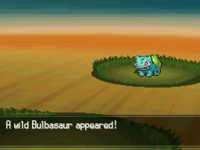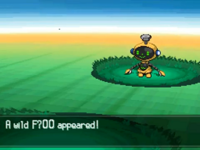Cheating
Cheating is a method of playing the Pokémon games which gives the player advantages that would not be available through normal gameplay. Cheating can be used to duplicate rare and valuable items and to obtain certain Legendary Pokémon which would not be available until a Nintendo event otherwise.
Methods of cheating
Glitches
- Main article: Glitch

While many glitches have no real in-game utility, it is possible to use some of them as a benefit for the player. The most well known examples of such thing are the Mew glitch and Tweaking, used in order to catch Mew and to catch Darkrai or Shaymin, respectively.
pRNG Manipulation
- Main article: Pseudorandom number generation in Pokémon → RNG abuse
pRNG manipulation (commonly dubbed RNG abuse) is a controversial topic amongst the Pokémon fandom. As a result of random number generators not being truly random, the numbers generated can be predicted. This allows users to, after calculating them, aim for specific traits, such as capturing Pokémon with multiple 31s for its Individual values, with a specific Nature, or shiny ones. While there is no interference with the game's coding from any external sources (indeed, the results obtained during pRNG manipulation can be obtained completely randomly), many see pRNG manipulation as a form of cheating, due to the resultant Pokémon being very difficult to obtain otherwise.
Cheating devices

Some players will use devices such as Action Replay to affect the execution of the game and easily obtain things they would otherwise need to work for. With cheating devices, players can simply alter the game's code to give them many other valuable Pokémon, making the hunt for shiny Pokémon and those with optimal IVs and Natures incredibly easy.
Cheating devices are commonly used to get Pokémon or items which are otherwise only obtainable through a Nintendo promotional events, if at all. Commonly, in Generation II and III, this means using the device to gain a special item to catch a Pokémon, such as the GS Ball or Old Sea Map.

A cheat that may be considered one of the most useful, the "Wild Pokémon Modifier" code is used to make any Pokémon of choice appear in any location, readily available for capture to build a collection of an unlimited amount of desired Pokémon easily with little to no negative effects to the save file. The wild Pokémon modifier code can also be used to make Pokéstar Studios opponents appear in Pokémon Black and White Versions 2, although as the game will attempt to bring up a nonexistent Pokédex entry upon capture, the game will freeze. An updated version of the modifier allows the player to set level and Nature. The cheat also makes EV-training much easier, by allowing Pokémon that give those EVs to be readily available.
In Pokémon Diamond and Pearl, a code which has been come to be known as the "walk anywhere code" allows cheaters access to any remote location by simply walking from one map location to another, sometimes passing through the Mystery Zone. This code also enables users to catch the Pokémon Shaymin and Darkrai.
Using the downloadable program, Pokésav, in conjunction with an Action Replay DS or ROM cartridges such as the R4, allows one to literally make their own Pokémon from scratch.
However, not all players will use cheating devices to make the game easier. In some cases, cheating devices can be used to make the game harder, such as the case where a player would use a code to trigger a battle with Professor Oak.
Criticism
The primary complaint against cheating methods is that it takes no particular ability to exploit a glitch or enter a cheat code, and thus detracts from the point and spirit of the game, making it less enjoyable. While this is a subjective matter, it is the primary cause of cheating offending most players.
Another more practical argument against cheating is that glitches and cheat codes often hurt the stability of the game. Many players have lost their Pokémon or save files while trying to exploit their game. On occasion, entire parties of Pokémon have been overwritten because of a destabilized glitch.
Some will justify using cheating devices to get Pokémon when they cannot attend Nintendo promotional events, the only legitimate way to obtain some Pokémon. It can also be at times the only way to acquire a certain item, such as the Lock Capsule, which in Pokémon Black and White contains TM95 (Snarl); or the GS Ball, which can be used to encounter Celebi. It is a matter of opinion whether or not this is a valid excuse for cheating.
Preventive measures
To combat cheating, Pokémon FireRed and LeafGreen have two measures to prevent cheating. Firstly, Mew and Deoxys were given special programming that prevents them from obeying the player if they were obtained illegitimately. However, this countermeasure fails if the player uses cheats to get to Faraway Island or Birth Island, and then catches the Pokémon in a somewhat legitimate manner. The countermeasure is negated if the Pokémon is caught in FireRed or LeafGreen and is then transferred to a Generation IV game. Secondly, special programming called DMA (dynamic memory allocation) is used in Generation III, and causes the data targeted by cheating devices to dynamically move around. However, this can be avoided by using codes to disable the DMA. Such codes are often referred to as "Master Codes".
Related articles

|
This game-related article is part of Project Games, a Bulbapedia project that aims to write comprehensive articles on the Pokémon games. |